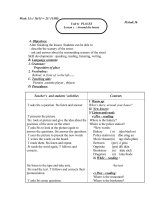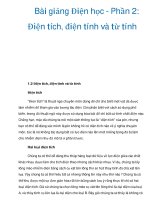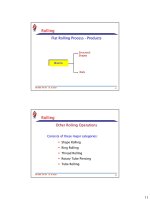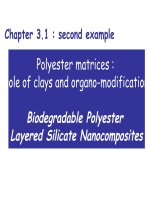bài giảng Nano composite phần 2
Bạn đang xem bản rút gọn của tài liệu. Xem và tải ngay bản đầy đủ của tài liệu tại đây (2.13 MB, 27 trang )
Polyester matrices :
role of clays and organo-modification
Biodegradable Aliphatic Polyesters
Biodegradable polymers with controllable life-time
Via enzymatic/hydrolytic chain cleavage and ultimate
bioassimilation
Biocompatible and bioresorbable materials
O (C H
2
)
5
C
O
n
PCL
Industrial production of PCL by Solvay, Dow (Union Carbide), Daicel,…
Miscible with numerous commercial thermoplastics…
e.g., PVC, SAN, ABS, CPE, nitrocellulose, polycarbonate, (PE),…
Poly(ε-caprolactone) :
Nanocomposites :
organic-inorganic materials
First
: to improve properties of PCL :
stiffness, gas barrier,
thermal behavior,…
Second
: to use highly filled PCL/clay nanocompositions as
«&masterbatch&» in various thermoplastic matrices,
i.e., PCL behaves as a clay-surface
compatibilizer
!
"#$$%&
"ε!&
nanometer scale dispersion
O (C H
2
)
5
C
O
n
PCL
Two main methods for PCL nanocomposite synthesis
!'
(
poly(caprolactone) + clay mixing in the
molten state
ring-opening
polymerization
ε-caprolactone + clay + catalyst
Clay = Montmorillonite
Na
x
(Al
4-x
Mg
x
)Si
8
O
20
(OH)
4
[CEC = 80-100 mequ./100 g]
from Southern Clay Products or Süd Chemie
commercial PCL
Mn = 50,000 g.mol
-1
Montmorillonite (modified)
3 wt%
melt blending on a two-roll mill at 130°C for 10 minutes
+
Poly(ε-caprolactone) nanocomposites by melt intercalation
basal spacing (d, Å) in code Ammonium cation
(organic fraction wt %)
a
clay PCL
composite
b
Mont-Na Na
+
(-) 12.1 12.3
Mont-COOH HOOC-C
11
H
22
NH
3
+
(11.2) 13.8 13.7
Mont-C
18
C
18
H
37
NH
3
+
(14.1) 18.7 25.6
Mont-Alk (CH
3
)
2
N
+
(C
18
H
37
)
2
(28.9) ca. 29.0
(broad)
36.0
Mont-(OH)
2
(CH
3
)(C
18
H
35
)N
+
(CH
2
CH
2
OH)
2
(20.1) 18.4 31.0
microcomposite
Intercalated
nanocomposite
a)&determined by TGA
b) PCL composite filled with $!% of layered silicates (precluding the organic
layer)
Pantoustier et al., e-Polymer, 9
(2001)
T.E.M. of melt intercalated nanocomposites
200 nm
Mont-C
18
Mont-Alk Mont-(OH)
2
C
18
H
37
NH
3
+
(C
18
H
37
)
2
N
+
(CH
3
)
2
(C
18
H
35
)(CH
3
)N
+
(CH
2
CH
2
OH)
2
Exfoliation of the silicate sheets in PCL never complete, it remains some stacks of
silicate layers whatever the alkylammonium cations considered
semi-intercalated/semi-exfoliated structure
~50nm
(Nanofil 848) (Nanofil 15) (Cloisite 30B)
Effect of clay content on elastic modulus
150
200
250
300
350
400
450
0 2 4 6 8 10
clay content (w t%)
Young modulus (MPa)
M MT-Na
M MT-Alk
M MT-(OH)2
microcomposite
nanocomposites
Tensile tests with a constant deformation rate : 50 mm/min
(638 type V ASTM norm)
Pantoustier et al., e-Polymer, 9
(2001)
)*+%
Effect of (organo)clay?
Intercalation/exfoliation?
- clay (montmorillonite) 1 to 10 wt-%
- slurry in ε-caprolactone (in bulk : no solvent)
Activation
: Sn or Al-based catalyst
O
O
Sn or Al Catalyst
O
(CH
2
)
5
O
n
n
Poly(ε-caprolactone) nanocomposites by
in situ
polymerization
Pantoustier et al, Polym. Eng. Sci., 42
(2002)
In-situ
polymerization
[monomer]/[Sn(Oct)
2
] = 300
3 wt-% clay
analysis by X-ray diffraction
Montmorillonite
N
+
CH
3
CH
3
C
8
H
17
C
18
H
37
intercalation
d = 18.5 Å
Montmorillonite
Na
+
intercalation
d = 12 Å
d = 19 Å d = 27 Å
Montmorillonite
N
+
CH
3
OH
OH
C
18
H
37
exfoliation
d = 20 Å
no peak
Pantoustier et al, Polym. Eng. Sci., 42
(2002)
100 nm
100 nm
Complete exfoliation
,!'
(catalysis by '
-
".&
-
T.E.M.
0 5 10 15 20 25 30
2 theta
counts
1 wt%
3 wt%
5 wt%
10 wt%
MMT-(CH
2
CH
2
OH)
2
3.25 Å
3.74 Å
4.14 Å
XRD
N
+
C
18
H
37
CH
3
OH
OH
Mont-(OH)
2
Lepoittevin et al., Macromolecules, 35
(2002)
Why exfoliation with MMT-(OH)
2
?
N
+
OHOH
R
N
+
OHOH
R
N
+
OHOH
R
N
+
OHOH
R
N
+
OHOH
R
N
+
OHOH
R
N
+
OHOH
R
N
+
OHOH
R
R=C
18
H
35
O
O
N
+
OH
OH
R
N
+
O
O
R
O
O
O
O
H
H
x
y
+ (x+y)
initiator
Catalyst
,!'
(catalysis by /0
', 24 h
[ROH] = [AlEt
3
]
Mont-(OH)
2
+ AlEt
3
Mont-(OAlEt
2
)
2
+ C
2
H
6
N
+
C
18
H
37
CH
3
OH
OH
Mont-(OH)
2
I
-
By !(in H
2
O at 85°C) of hydroxy-functionalized
and non functionalized ammonium cations :
Na
+
Na
+
C
18
H
37
N
CH
3
CH
3
CH
2
CH
2
OH
I
-
C
18
H
37
N
CH
3
CH
3
CH
3
C
18
H
37
N
CH
3
CH
3
CH
2
CH
2
OH
C
18
H
37
N
CH
3
CH
3
CH
3
1.21nm
with 0, 25, 50, 75 and 100%
intercalated ω-OH ammonium cations
(ca. 21~wt-% organic
modifier)
~1.9nm
0
500
1000
1500
2000
2500
3000
0 5 10 15 20 25 30
2-theta
counts
Mont-OH with 100% OH
1.90 nm
PCL-«&grafted&» clay nanohybrids : grafting density control
Lepoittevin et al., J. Mater. Chem., 12
(2002)
PCL-« grafted » clay nanohybrids : grafting density control
3 wt-% Mont-OH
(x%)
0
2000
4000
6000
8000
0 5 10 15 20 25 30
2-theta
counts
0% OH
25% OH
50% OH
75% OH
100%OH
Intercalation
Exfoliation
Lepoittevin et al., J. Mater. Chem., 12
(2002)
3 wt-% Mont-OH
(100%)
100 nm
~300nm
PCL-« grafted » clay nanohybrids : grafting density control
OHHO
O O O
O OO
Where represents the long alkyl chain ammonium
cations, some of them bearing an hydroxyl function (–OH)
Polymerization
Induced
phase-separation
Polymer patch (~ 2-3 nm high)
"grafted" polymer layer
(5-8 nm thick)
Individual clay
platelet (~ 1nm thick)
low grafting
density
high grafting
density
< 50% (OH)
≥ 50% (OH)
MMT surface
Polymerization (cont’d)
Growing
solvated polymer
OHHO OHOHHOHO
O O OOO OO OO
O OOO OOOO OOOOO
Where represents the long alkyl chain ammonium
cations, some of them bearing an hydroxyl function (–OH)
Where represents the long alkyl chain ammonium
cations, some of them bearing an hydroxyl function (–OH)
Polymerization
Induced
phase-separation
Polymer patch (~ 2-3 nm high)
"grafted" polymer layer
(5-8 nm thick)
Individual clay
platelet (~ 1nm thick)
low grafting
density
high grafting
density
< 50% (OH)
≥ 50% (OH)
MMT surface
Polymerization (cont’d)
Growing
solvated polymer
Controlled polymer grafting on clay platelets
Proposed mechanism:
Viville et al., J. Amer. Chem. Soc.,
2004
Nanohybrids by sequential copolymerization of ε-
caprolactone and L,L-lactide from activated clay surface
N
+
C
16
H
33
O C CH
2
O
O Al
n
5
Et
Et
N
+
C
16
H
33
O
O
O
O
O
O
N
+
C
16
H
33
O C CH
2
O
O
n
5
C CH
O
CH
3
O H
m
N
+
C
16
H
33
N
+
C
16
H
33
OH
N
+
C
16
H
33
N
+
C
16
H
33
O Al
Et
Et
N
+
C
16
H
33
AlEt
3
-
-
2.
CL
3.
4.
LA
H
3
O
+
-
-
1.
-
(-C
2
H
6
)
- -
-
toluene
, toluene
toluene
Pollet et al., Macromol. Chem. Phys.,
2004
Nanohybrids by sequential copolymerization of ε-
caprolactone and L,L-lactide from activated clay surface
0
200
400
600
800
1000
1200
1400
1600
0 2 4 6 8 10 12 14
2 theta angle (°)
counts (a.u.)
MMT + PCL-b-PLA
MMT + PCL
Cloisite30B
a)
b)
c)
a)
b)
c)
Pollet et al., Macromol. Chem. Phys.,
2004
Catalyzed
ROP
O
O
O
O
O
O
O
O
O
O
O
O
O
O
O (C H
2
)
5
C
O
n
O (C H
2
)
5
C
O
n
Mont-(OH)
2
0#
121013 .
Highly filled PCL
Melt blending
Lepoittevin et al., Polymer, 44
(2003)
45
5
56!'(
0
20
40
60
80
100
250 300 350 400 450 500 550
temperature °C
weight %
PCL
1 w t%
3 w t%
5 w t%
10 w t%
Conditions : 20°C/min. under air flow
Thermogravimetric analysis of PCL-grafted Mont-(OH)
2
exfoliated in PCL via «&masterbatch&» process : ###
PCL 50K
Lepoittevin et al., Polymer, 44
(2003)
PVC / (PCL-grafted) Mont(OH)
2
nanocomposites via « masterbatch
»
process
0 2 4 6 8 10
2-theta
MMT-(OH)
2
PVC + MMT-(OH)
2
PVC + masterbatch M3
3.88 nm
1.85 nm
(50% clay/50%PCL)
Exfoliation
Intercalation
(Melt blending at 155°C for 15 min.)
Lepoittevin et al., Polymer, 44
(2003)
CPE / (PCL-grafted) Mont(OH)
2
nanocomposites via « masterbatch
»
process
500 nm
5 00 nm5 00 nm5 00 nm
500 nm
Nanocomposites based on 3wt% clay dispersed in stabilized CPE matrix
The large "round" particles are additives within the commercial CPE matrix
Via the PCL-grafted MMT masterbatchWith MMT-OH
2
7#0$*$% 7!"8&
+9*
(melt blending at 175°C; ASTM D638 typeV)
CPE with 36wt% chlorine (Tyrin®3652) from Dupont Dow Elastomers
and stabilized by 4 phr Lankroflex® E2307 (epoxidized soybean oil)
500 nm
CPE+ 14wt% PCL(4K)
CPE
CPE+ PCL-grafted MMT
With elongation at break > 900%
masterbatch process :
application to PLA
nanocomposites
Cloisite
®
30B / PLA
nanocomposites
with 3 wt% of
loading
In situ
polymerisation
1.
1.
Highly filled (53 wt
%) Cloisite
®
30B / PLA
nanocomposite
Preformed PLA
(commercial matrix)
PLA (70% S-lactic
acid)
2.
2.
Melt blending
Paul et al., Macromol. Chem. Phys.,
2005
PLA nanocomposites via masterbatch
process
Morphology
Morphology
Cloisite
®
30
B
Masterbatch
(53 wt%
inorganic)
Cloisite
®
30B / PLA
nanocomposites
with 3 wt% of
loading
Exfoliation of clay
platelets









